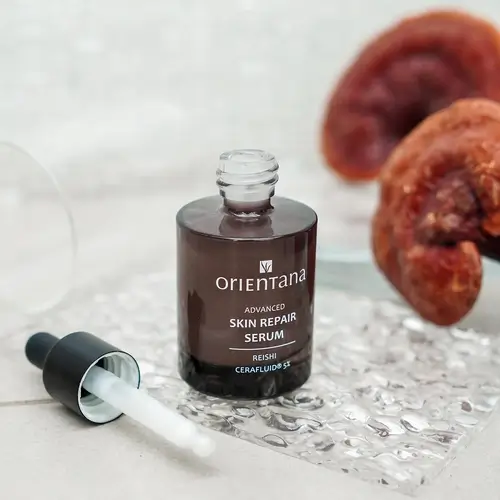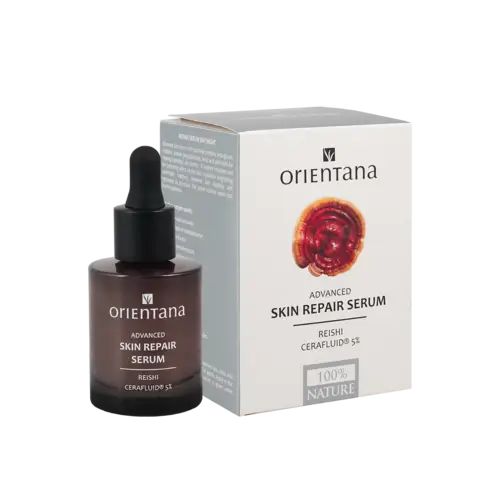Ceramides are lipids (fats) that are an essential part of the skin's natural protective barrier. They are found in the stratum corneum (the outermost layer of the skin) and play a key role in maintaining proper hydration and protecting against harmful external factors.
What do ceramides do? First of all, they act as skin protection. They create a barrier that protects the skin from water loss and from external factors such as pollution, bacteria or UV radiation. Ceramides in cosmetics also have the function of maintaining moisture. Thanks to them, the skin is more moisturized, because ceramides help retain water in the epidermis, which prevents the skin from drying out. Another important function is regeneration. They help rebuild and strengthen the damaged skin barrier, supporting skin regeneration, which is especially important in the case of dry, sensitive or damaged skin.

How do Ceramides work in cosmetics?
Due to their protective and moisturizing properties, ceramides are a popular ingredient in skin care products such as creams and serums. Cosmetics with ceramides can be especially beneficial for people with dry, sensitive or atopic skin, as they support the reconstruction of the natural lipid barrier.
If the skin's protective barrier is damaged (e.g. by external factors, aggressive cosmetics or the aging process), ceramides can help regenerate it, improving skin hydration and elasticity.
Ceramides are considered an extremely effective ingredient in skin care cosmetics, especially when compared to other ingredients.
A natural ingredient of the skin
Ceramides are lipids that naturally occur in the stratum corneum (the outer layer of the skin). They make up about 50% of the lipids that make up the skin barrier. Their main role is to maintain moisture in the skin and protect it from external factors such as pollution, bacteria and UV radiation.
Rebuilding the skin barrier
Ceramides effectively help to regenerate a damaged skin barrier. If the skin is dry, irritated or damaged, ceramides can help repair this damage by supporting the regenerative processes. Unlike other ingredients that may act more superficially, ceramides help to rebuild the skin's structure at the cellular level.
Water retention in the skin
One of the most important functions of ceramides is to maintain the skin’s moisture levels. They create a “protective barrier” that prevents excessive water loss, which is essential for healthy, moisturized, and supple skin. Many other moisturizing ingredients (e.g. glycerin, hyaluronic acid) work more by binding water from the outer layers of the skin, while ceramides work internally to provide long-lasting hydration.
Gentleness and safety
Ceramides are gentle to the skin, even sensitive, allergic or atopic. Because they are a natural component of the skin, they very rarely cause irritation or allergies, which makes them ideal even for people with skin problems such as atopic dermatitis, eczema or psoriasis.
Compatibility with other ingredients
Ceramides work well with many other active skincare ingredients, such as retinol, niacinamide, vitamins and antioxidants. They enhance their effects while minimizing the risk of irritation, making them a universal ingredient in a skincare routine.
Anti-aging effect
As we age, the amount of ceramides in our skin decreases, which leads to dryness, loss of elasticity, and wrinkling. Supplementing with ceramides in your skincare routine helps combat these signs of aging by improving skin hydration and firmness, making your skin look younger and healthier.
Protective action
Ceramides strengthen the skin's protective functions, which helps prevent the penetration of harmful substances, bacteria and allergens. This makes the skin less susceptible to irritation and inflammation, which is crucial for the health of the skin in the long term.
types of ceramides in cosmetics
Ceramides, which are lipids found in the stratum corneum of the epidermis, come in different forms that perform slightly different functions in protecting and moisturizing the skin. Below are the main types of ceramides that can be found in both skin and skin care products.
Ceramide 1 (Ceramide EOP)
Ceramide 1, also known as EOP ceramide, is particularly important for strengthening the skin's structure and integrity. It contains fatty acids that help to hold epidermal cells together. It is responsible for stabilizing the lipid barrier and is particularly important for dry or damaged skin. Often used in regenerative products.
Ceramide 2 (Ceramide NS / NG)
Ceramide 2, also called ceramide NS or NG, is one of the most important ceramides responsible for skin hydration. It helps bind water in the skin, maintaining its optimal level of hydration. This ceramide is crucial for dehydrated and dry skin.
Ceramide 3 (Ceramide NP)
Ceramide 3, known as ceramide NP, is one of the most commonly used in cosmetics. It is also a stabilizing and replenishing ingredient of the skin's natural lipid barrier. It supports skin regeneration, restoring its natural protective and moisturizing functions. It is particularly beneficial in products for sensitive, dry or atopic skin.
Ceramide 6-II (Ceramide AP)
Ceramide 6-II, also known as AP ceramide, has exfoliating properties, meaning it helps slough off dead skin cells. It has a smoothing effect on the skin, supporting the natural cell renewal process, which improves the skin’s texture. This type of ceramide is often found in products designed to combat the signs of aging.
Ceramide 9 (Ceramide EOS)
This is a less popular but important ceramide with similar effects to ceramide 1, acting as a skin barrier enhancer. It helps maintain the integrity of the skin barrier by protecting it from harmful external factors such as pollutants and bacteria.
Ceramide 4 and 5
Ceramides 4 and 5 are found in smaller amounts in the skin and have less well-studied effects, but like other ceramides, they have a stabilizing and protective function in the stratum corneum. They support the overall skin barrier.
Synthetic and other forms of ceramides:
In addition to the natural ceramides found in the skin, there are also synthetic ceramides that are commonly used in cosmetics. These are created in a lab and are designed to mimic the effects of natural ceramides, providing similar benefits, such as rebuilding the lipid barrier and hydrating the skin.

Ceramide Serum
Ceramide serum is an excellent cosmetic for repairing the hydrolipid barrier and strengthening the epidermis. It maintains hydration and has a smoothing effect. An important complex contained in this serum is CeraFluid®. CeraFluid® is a specialized cosmetic complex containing ceramides in liquid form, developed for easier integration with skin care products. Its main goal is to moisturize, regenerate and rebuild the skin's protective barrier, thanks to the content of ceramides, which are a natural component of the lipid barrier of the epidermis. CeraFluid® can be used in various cosmetics, such as creams, serums, balms, hair care products, thanks to its flexibility and ease of integration with various formulations. The complex helps the skin cope better with external factors, such as pollution, aggressive atmospheric factors or UV radiation, which can damage the skin barrier.
Cerafluid is valued in cosmetics primarily for its ability to intensively regenerate and protect the skin, as well as for its ability to improve the elasticity and overall appearance of the skin. It is used in products for dry, sensitive and aging skin.
CeraFluid® reduces the visibility of wrinkles in vivo and improves skin elasticity and smoothness.
From a formulation perspective, standard ceramides are ingredients that require high processing temperatures (above 90°C) and solubility to be effective. CeraFluid® is different and unique! A natural oil solvent based on pure ingredients isolated from olive oil (purified tri- and di-glycerides) enables CeraFluid® to be available in cosmetic formulations: it is already liquid at 40°C and can be easily formulated with all types of natural oils.






